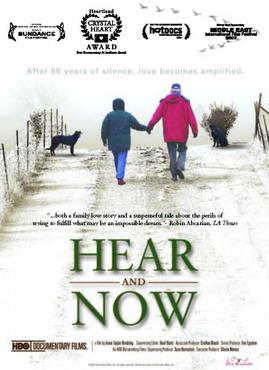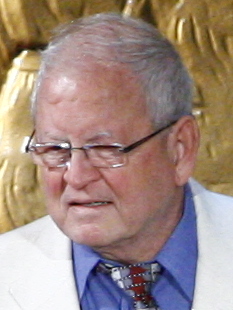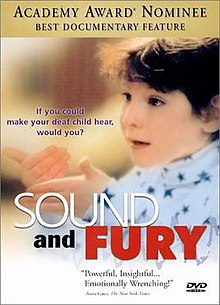This is a glossary of medical terms related to communication disorders which are psychological or medical conditions that could have the potential to affect the ways in which individuals can hear, listen, understand, speak and respond to others.

A cochlear implant (CI) is a surgically implanted neuroprosthesis that provides a person who has moderate-to-profound sensorineural hearing loss with sound perception. With the help of therapy, cochlear implants may allow for improved speech understanding in both quiet and noisy environments. A CI bypasses acoustic hearing by direct electrical stimulation of the auditory nerve. Through everyday listening and auditory training, cochlear implants allow both children and adults to learn to interpret those signals as speech and sound.

Deaf culture is the set of social beliefs, behaviors, art, literary traditions, history, values, and shared institutions of communities that are influenced by deafness and which use sign languages as the main means of communication. When used as a cultural label especially within the culture, the word deaf is often written with a capital D and referred to as "big D Deaf" in speech and sign. When used as a label for the audiological condition, it is written with a lower case d. Carl G. Croneberg coined the term "Deaf Culture" and he was the first to discuss analogies between Deaf and hearing cultures in his appendices C/D of the 1965 Dictionary of American Sign Language.
Oralism is the education of deaf students through oral language by using lip reading, speech, and mimicking the mouth shapes and breathing patterns of speech. Oralism came into popular use in the United States around the late 1860s. In 1867, the Clarke School for the Deaf in Northampton, Massachusetts, was the first school to start teaching in this manner. Oralism and its contrast, manualism, manifest differently in deaf education and are a source of controversy for involved communities. Oralism should not be confused with Listening and Spoken Language, a technique for teaching deaf children that emphasizes the child's perception of auditory signals from hearing aids or cochlear implants.
Unilateral hearing loss (UHL) is a type of hearing impairment where there is normal hearing in one ear and impaired hearing in the other ear.
Graeme Milbourne Clark is an Australian Professor of Otolaryngology at the University of Melbourne. Worked in ENT surgery, electronics and speech science contributed towards the development of the multiple-channel cochlear implant. His invention was later marketed by Cochlear Limited.

Cochlear is a medical device company that designs, manufactures, and supplies the Nucleus cochlear implant, the Hybrid electro-acoustic implant and the Baha bone conduction implant.
Congenital hearing loss is a hearing loss present at birth. It can include hereditary hearing loss or hearing loss due to other factors present either in-utero (prenatal) or at the time of birth.

Hear and Now is a 2007 documentary film by Irene Taylor Brodsky, winning awards in 2007 at the Sundance Film Festival and the Heartland Film Festival; and garnering a Peabody Award in 2008.
An auditory brainstem implant (ABI) is a surgically implanted electronic device that provides a sense of sound to a person who is profoundly deaf, due to retrocochlear hearing impairment. In Europe, ABIs have been used in children and adults, and in patients with neurofibromatosis type II.
Sound and Fury may refer to:

Paul Taylor was an American engineer, a pioneer in development of telecommunications devices for the deaf. He also enjoyed a kind of celebrity status because of his central role in the award-winning documentary Hear and Now. The film by daughter Irene Taylor Brodsky chronicles the before and after experiences of her parents, Paul and Sally Taylor, both of whom underwent cochlear implant surgeries in their mid-60s after a lifetime of deafness.
Auditory-verbal therapy is a method for teaching deaf children to listen and speak using their hearing technology. Auditory-verbal therapy emphasizes listening and seeks to promote the development of the auditory brain to facilitate learning to communicate through talking. It is based on the child's use of optimally fitted hearing technology.
Prelingual deafness refers to deafness that occurs before learning speech or language. Speech and language typically begin to develop very early with infants saying their first words by age one. Therefore, prelingual deafness is considered to occur before the age of one, where a baby is either born deaf or loses hearing before the age of one. This hearing loss may occur for a variety of reasons and impacts cognitive, social, and language development.

Henryk Skarzynski is a Polish doctor otolaryngologist, audiologist and phoniatrist, creator and director of Warsaw Institute of Physiology and Pathology of Hearing and World Hearing Center in Kajetany.
Language acquisition is a natural process in which infants and children develop proficiency in the first language or languages that they are exposed to. The process of language acquisition is varied among deaf children. Deaf children born to deaf parents are typically exposed to a sign language at birth and their language acquisition follows a typical developmental timeline. However, at least 90% of deaf children are born to hearing parents who use a spoken language at home. Hearing loss prevents many deaf children from hearing spoken language to the degree necessary for language acquisition. For many deaf children, language acquisition is delayed until the time that they are exposed to a sign language or until they begin using amplification devices such as hearing aids or cochlear implants. Deaf children who experience delayed language acquisition, sometimes called language deprivation, are at risk for lower language and cognitive outcomes. However, profoundly deaf children who receive cochlear implants and auditory habilitation early in life often achieve expressive and receptive language skills within the norms of their hearing peers; age at implantation is strongly and positively correlated with speech recognition ability. Early access to language through signed language or technology have both been shown to prepare children who are deaf to achieve fluency in literacy skills.
Deafness has varying definitions in cultural and medical contexts. In medical contexts, the meaning of deafness is hearing loss that precludes a person from understanding spoken language, an audiological condition. In this context it is written with a lower case d. It later came to be used in a cultural context to refer to those who primarily communicate through sign language regardless of hearing ability, often capitalized as Deaf and referred to as "big D Deaf" in speech and sign. The two definitions overlap but are not identical, as hearing loss includes cases that are not severe enough to impact spoken language comprehension, while cultural Deafness includes hearing people who use sign language, such as children of deaf adults.

The Deaf rights movement encompasses a series of social movements within the disability rights and cultural diversity movements that encourages deaf and hard of hearing to push society to adopt a position of equal respect for them. Acknowledging that those who were Deaf or hard of hearing had rights to obtain the same things as those hearing lead this movement. Establishing an educational system to teach those with Deafness was one of the first accomplishments of this movement. Sign language, as well as cochlear implants, has also had an extensive impact on the Deaf community. These have all been aspects that have paved the way for those with Deafness, which began with the Deaf Rights movement.
Treatment depends on the specific cause if known as well as the extent, type, and configuration of the hearing loss. Most hearing loss results from age and noise, is progressive, and irreversible. There are currently no approved or recommended treatments to restore hearing; it is commonly managed through using hearing aids. A few specific types of hearing loss are amenable to surgical treatment. In other cases, treatment involves addressing underlying pathologies, but any hearing loss incurred may be permanent.
Heather Artinian is a Deaf American lawyer who was the subject of the documentary Sound and Fury when she was a child. Although her parents initially opposed letting her get the cochlear implant, they eventually let her get one in 2002, and she went on to attend a mainstream school.







